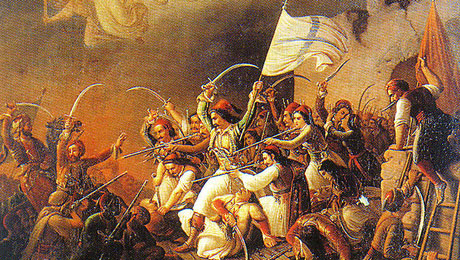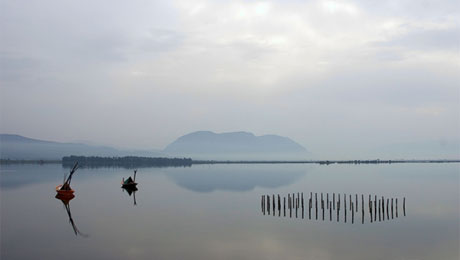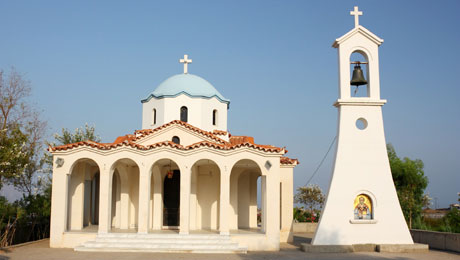Picture: www.clickatlife.gr
A magical water world near a heroic city with a rich history makes Messolonghi and the surrounding area perfect for a spring walk.
Messolonghi is famous for two reasons - because of the heroic struggle of its residents during the revolution in 1821 and because of its unique lagoon. There are people who also know other secrets of the city which is located in an area which is the richest in fish in the country.
It is located 249 km from Athens on an alluvium shoulder that is formed between the eponymous lagoon and the lagoon of Klisova (http://bit.ly/14OMXGM), overlooking the unique beauty of the underwater world.
The walls and gates of the city are still magnificent. You can also visit the Green Park of Heroes behind the walls of the city, where many heroes who fought in the Revolution were buried. Each year, on Palm Sunday, the city celebrates the day of the memory of its heroic outcome. There are a lot of old houses in Messolonghi that are easily distinguishable in the contemporary urban network.

Take a walk along Markou Botsari square in the city centre, where the old town hall is located. It houses the Museum of History and Art. A bit further down the street, two historic houses have been converted into museums: the house of poet Kostis Palamas and the house of the Tricoupises, where two prime ministers of Greece lived. The library of Valvios is also located in the centre with rare books and documents, as well as the contemporary art gallery with many works of Greek artists and other interesting sights.
To the north, along the old road that connects Messolonghi with Etoliko, just 3 km from the city near Phoenicia, the church of Panagia tis Finikias is located on the lake. Once a favourite place for recreation of Lord Byron, it is definitely worth visiting.
The Sacred City
The city of Messolonghi is called the sacred city because it is associated with the revolution of 1821. The gate at the exit, the ground barrier, the Green Park of Heroes with the tomb in which revolutionaries such as Marcos Botsaris, Kyriakos Mavromichalis and Lord Byron were buried - these are just some of the places showing the role of the city in the combat for independence. The art gallery of the city hall shows a unique collection of artists from Greece and abroad from the 19th and 20th century, dedicated to 1821.

At the time of Ali Pasha, Messolonghi revolted on May 1821 and the city was one of the main Greek forces in the liberation struggle. Its inhabitants faced Ottoman attacks in 1822 (the first siege of Messolonghi) and 1823 (the second siege of Messolonghi). The third attack began on April 1825 at Kutahya. Ibrahim tried to exhaust the besieged by interrupting all lines of communication and supplies. Messolonghi remained under Turkish rule for 3 more years, and on 2 May 1829 the city was returned with the contract of the New Greek state.
The lagoon - the source of life

Messolonghi lagoon, the largest in the country, with its picturesque huts in the water is protected by the Ramsar treaty. This is a place of unique beauty and ecological value, rare flora and 280 species of birds. The lagoon is ideal for fish farming, and many villagers are engaged in fishery. Fish that are caught here include sea bass, sea bream and mullet. The famous dried roe of Messolonghi is derived from the female mullet – it is a natural product that contains no preservatives and is rich in omega-3 fatty acids. The spectacular lagoon of Messolonghi also offers another treasure of the city - salt. This is the largest salt-mine in Greece, producing about 60% of the salt in the country. In the region, one can also enjoy activities such as bird-watching, fishing with traditional techniques, and walks around ecosystems and huts of fishermen.
Etoliko

This place with about 5,500 inhabitants, known as "The Little Venice" is the "highlight" in the canter of the lagoon, with picturesque narrow streets and low houses full of flowers. It is located on a small island 10 km from Messolonghi. In 2002, the bridges of Etoliko were recognised as historical monuments that need special government protection. They are an example of construction equipment from the late 19th century.
The Centre of Woodcarving is also worth visiting – the Vasso Katraki Museum (www.vassokatraki.gr). In one of its two large halls, you will see works by artist Vasso Katraki while the other hall houses visiting exhibitions. In the middle of a rare ecosystem, this small town is surrounded by nature reserves rich in various animal species protected by the Ramsar Treaty and other international agreements.
Traditional Easter

The best time to visit the area is the spring, when nature blooms. If you are there at Easter you will have the opportunity to celebrate in the way locals celebrate. In Etoliko, on Good Friday believers attend the church of the Assumption which hosts the Shroud from the 13-14th century, and the miraculous icon of the Virgin Mary, painted by Luke the Evangelist. From the morning of Holy Saturday, many traditions come alive in the central square of the city: barbecues, dances and songs that last until the morning.
More information about Messolonghi and Etoliko can be found at www.aitoliko.gov.gr, www.messolonghi.gr and www.messolonghi.gov.gr.